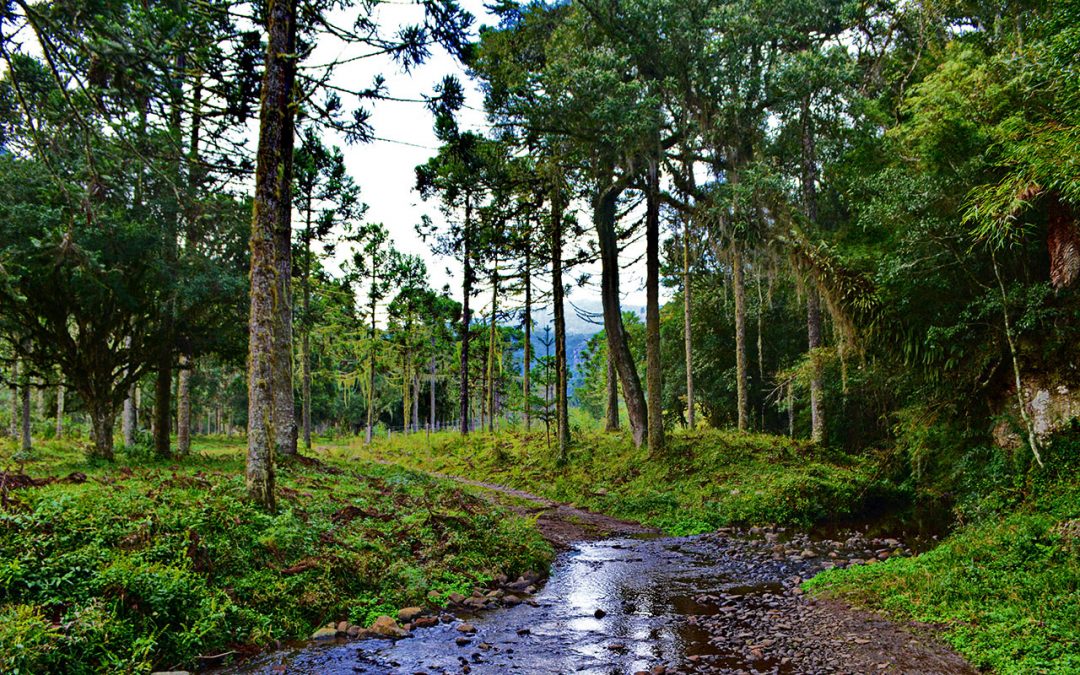Also known as Pine Forest or Mixed Ombrophilous Forest, the Araucária Forest is a type of ecosystem in which there is a predominance of trees called Pinheiro-do-Paraná, or Araucária. This species has characteristics that allow its survival in rainy climates and low temperatures. They share land with several other animal and plant species, including mate herb, which, besides being a constituent part of the native flora, therefore of great biological importance, is very important for the national economy.
This ecosystem is predominantly present in the southern region of Brazil, especially in the states of Santa Catarina and Paraná, beginning on the first plateau, west of Serra do Mar, followed by the second and third plateaus of the state of Paraná, extending in smaller proportions, for São Paulo, Rio de Janeiro and Minas Gerais. Araucária is the symbolic tree of Paraná, due to its exuberance and for having occupied more than half of the state in the past.
In addition to the majestic Pinheiro-do-Paraná, we find in this forest, a huge plant diversity, such as: xaxins, pines, cedros rosa, ipês, cinnamon trees, imbuias, jabuticabas, tarumãs, taquaras, bromeliads, guava trees, mate herb, among others. Currently the Araucária is on the list of endangered flora. Since 1890 the extraction of Araucárias and the devastation of the Mixed Ombrophilous Forest in Paraná has been intensifying, and as a result, nowadays only 1% of the original portion of this ecosystem remains.
The Araucária Forest is characterized by subtropical climate, indicating high thermal amplitude, therefore, the seasons are relatively well defined: winters are cold, with frequent frosts, and hot summers have higher temperatures.
The Pinheiro-do-Paraná
Popularly known as Araucária, Pinheiro-do-Paraná, or just Pine tree, Araucária angustifolia, when grown, can measure from 20 to 50 meters in height. Araucária trees are dioecious, meaning there is a female and a male tree. In the female tree, in a structure called strobilus, or pine cone, develop the pine nuts, which are the seeds of Araucárias. These trees do not produce fruit. Its diameter can vary from 90 to 180 cm, with a thick, purplish brown, scratchy and rough bark.

When the tree is mature, the crown has a peculiar shape, because as the trunk grows in a straight line without any deviation, the tree branches only at the top; its branches develop horizontally with the ends curved upwards, overlapping each other, thus forming several floors.
Biodiversity
Araucária Forest is one of the richest ecosystems in terms of animal and plant species, as it is located in the Atlantic Forest. In this sense, it is important to remember the need for conservation of this environment, as many of these species are threatened with extinction, and some of them only develop in this specific ecosystem.
Among the animals that inhabit this area, we can highlight the jaguar, the ocelot, the southern muriqui monkey, the tufted capuchin, the brown howler, the golden lion tamarin, the marmosets, the sloth, the Guianan squirrel, the anteater, the guans, the jacutinga, the brazilian tanager, the neotropical bellbird, the hummingbirds, toucans, gaturamos, azure jay among countless other species.
The gralha-azul
The culture of the communities living in the Araucária Forest region tells the story of the blue jay, a very beautiful bird with the blue plumage that motivated in Paraná the tradition of planting pine trees. The blue jays bury the pine seeds to eat later, but they forget the location or find other foods, not having the need to return to the pinion buried, allowing the seeds to germinate and give rise to new Araucárias.
Legend has it that a certain crow slept on a pine branch and was awakened by the sound of an ax’s blows. Startled, she flew into the clouds, not to witness the scene of the pine extermination. Up in the sky, she heard a voice asking her to return to the pine woods, so that she would be dressed in sky blue and would start planting pine trees. The crow accepted the mission and was completely covered with blue feathers, except around the head, where the black of the raven remained. She then returned to the pine groves and began to spread the araucária seed, according to divine desire.
Nowadays she is legally protected against hunting and considered the protector of pine woods.
São Luiz do Purunã and the Araucárias
You can enjoy all the beauties and riches of this ecosystem that is an intangible heritage of Brazil, visiting São Luiz do Purunã, in Balsa Nova, Paraná, to go hiking and get to know the local ecotourism. Enjoy spending a day with nature, contemplating biodiversity and renewing energies.
Click here and access the site Visit Purunã to know about gastronomic options, leisure, accommodation, events agenda and and a little of the history of the region, and come to honor the Routes of Purunã and the vegetation of the Araucária Forest of our state!

